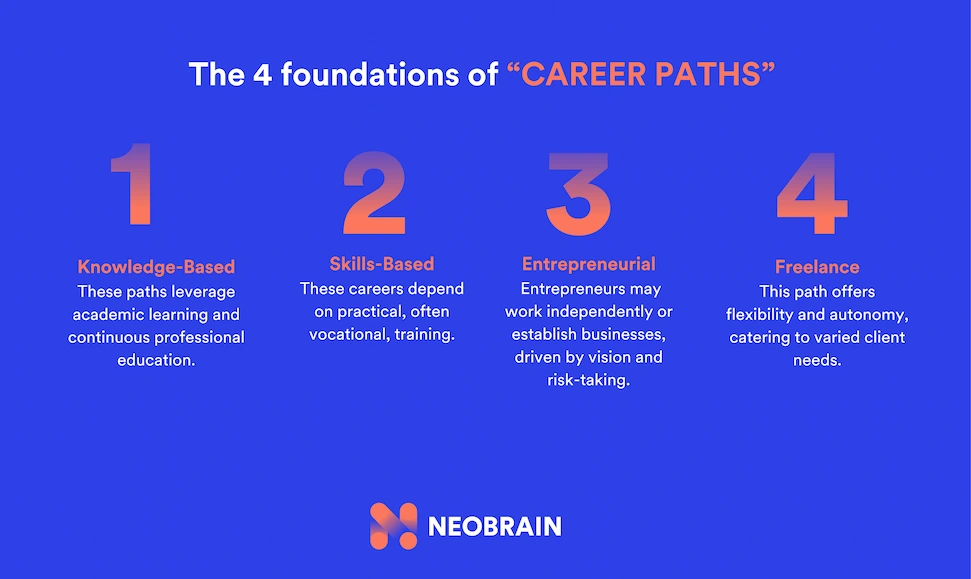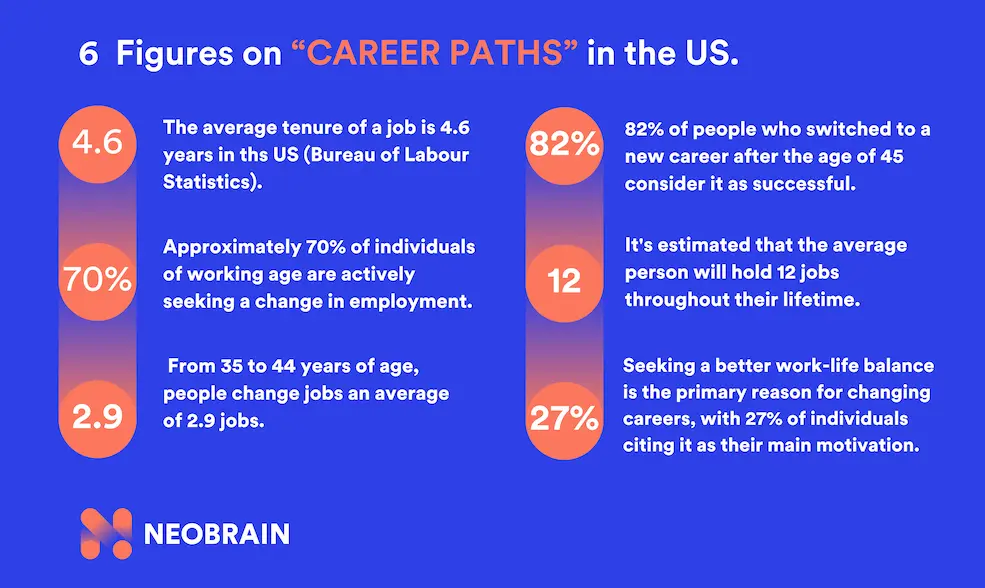According to the World Economic Forum, it is estimated that we will have between 13 and 15 jobs in our lifetime. These figures reflect not only changes in employers, but also, and increasingly, changes in professions.
Career paths are no longer linear, but take the form of a mosaic of possibilities leading to personal fulfillment and organizational success. What does this mean for individuals seeking to navigate in an environment as complex as ours?
The variety of career paths reflects not only personal choice, but also external pressures and organizational changes. How can organizations adapt to provide a nurturing ground for employees’ ambitions, offering the right mix of opportunities, tools and perspective?
What are career paths?
A career path represents a strategic roadmap crafted not only for individuals to progress through a sequence of roles that enhance their skills, responsibility, and fulfillment but also for organizations to equip and guide their talents towards opportunities that align personal aspirations with organizational performance.
A career path is a synergy of individual ambition and organizational support, mapping a journey of roles that elevate skills and fulfillment, driving personal and corporate success alike
A few figures on career paths:
- The average tenure of a job in the US is 4.6 years (Bureau of Labour Statistics).
- Around 70% of employees are actively seeking a change of job opportunities.
- Between the ages of 35 and 44, people change jobs an average of 2.9 times.
- 82% of people who switched to a new career after the age of 45 consider it has been successful.
- It is estimated that the average american person will hold 13 jobs over the course of his or her life.
- The search for a better work-life balance is the main reason for career change for 27% of individuals.
Career paths for employees
Today, career paths are becoming more individualized and unique, based on a succession of more or less varied professions. They no longer respond solely to the needs of organizations, but increasingly to the personal aspirations that these same companies strive to capture, with varying degrees of success.
==> On this subject, read our article: Understanding individual talent aspirations
For professionals, it’s all about creating a path that offers growth, learning and fulfillment, whether through so-called “vertical” growth or cross-functional developments, or even complete job changes.
Examples of career paths:
Traditional career journeys
- In Retail : Salesperson > Department manager > Store manager > Regional manager > Operations manager
A career in retail often begins in the field, with progression to managing individual departments, whole stores, and eventually the supervision of several outlets or the strategic direction of sales operations.
- For jobs in logistics: Logistics Coordinator > Supply Chain Analyst > Supply Chain Manager > Supply Chain Operations Manager > VP of Supply Chain
In the supply chain sector, professionals can start in logistics support, move into analytical and managerial roles, and rise to executive positions focused on optimizing the entire supply chain process.
- In clinical research: Clinical Research Coordinator > Clinical Research Associate > Clinical Project Manager > Director of Clinical Operations > Scientific Director (CSO)
This pathway highlights opportunities in the healthcare and pharmaceutical industries for those interested in advancing medical knowledge and patient care through research.
Here’s an example of how Neobrain’s career management platform can be used to suggest possible career paths within a company in the retail sector.
Unconventional career journeys
Retail salesperson > Recruitment consultant > Body shop recruitment manager > HR software salesperson > Inbound marketing manager for an HR software company
This path illustrates how skills acquired in one role can be transferred to completely different areas, highlighting adaptability, continuous learning and the ability to see the wider application of talent skills. It reflects a career shaped by seizing opportunities, adapting to new industries and strategically applying skills across diverse roles.
Career transition is progressing evenly on all continents. Our article on this phenomenon sheds light on why and how: identify your skills for a successful reconversion.
The role of career pathing for companies
Benefits of supporting employee career pathing for companies
Companies need to nurture this diversity of career paths, while recognizing that the key to success lies in aligning employees’ ambitions with the company’s strategic objectives.
This dual focus promises mutual benefits: individuals reach their career milestones, while organizations cultivate an adaptable workforce in circumstances of redeployment linked to changing professions.
Neobrain provides a free platform where you’ll find the impacts of AI on 100 professions: anticipate the changes of skills now.
The 2 different types of career paths
Understanding the underlying aspirations and often unexpressed assumptions of talent can help individuals and organizations tailor development opportunities more effectively.
Vertical and lateral career évolutions
What do we mean by “vertical path”?
Vertical progression involves advancing within an organization towards roles with greater responsibility, strategic influence and remuneration. The typical example is that of a path towards management positions and influence over the organization. This format is no longer identified as the royal road, as 62% of employees no longer aspire to it.
What do we mean by “lateral path”?
This type of path focuses on broadening one’s set of skills through new challenges in different fields. Often without immediate promotion or salary increase, this path aims to acquire diverse experiences to improve one’s adaptability.
The 4 pillars of a successful career path

- Knowledge-based: relies on accumulated knowledge to perform tasks associated with the function. These pathways leverage academic learning and continuing professional education.
- Skills-based: this type of career path focuses on specific job functions that require practical, physical or service skills . These careers depend on practical, often vocational, training.
It’s worth pointing out here that the accelerating obsolescence of skills has given way to a new form of organization based on the continuous adaptation of talent: this is known as the “ skills-centric organization“.
- Entrepreneurship: involves solving problems or satisfying needs with innovative products or services. Entrepreneurs can work independently or establish businesses, driven by vision and risk-taking.
- Freelance: freelancers or independent contractors offer specialized services on a project basis, covering graphic design, consulting, and more. This path offers flexibility and autonomy, meeting the varied needs of customers.
Many careers today are cross-disciplinary, blending in-depth specialist knowledge with practical skills . Recognizing the dynamic interplay between these elements enables a richer understanding of career development, adapting to each individual’s unique talents and aspirations.
The benefits of clear career paths for employees and the company
Significant professional achievements for employees
- Greater visibility of possible trajectories:
Taking a step back to map opportune career paths gives employees a clear understanding of the options available to them. This clarity not only improves job satisfaction by enabling individuals to target roles that resonate with their aspirations, but for the company it provides a roadmap for succession planning.
- Skills developement:
By identifying career goals, employees can determine the skills and qualifications required for their desired roles, guiding their professional development path. This aspect of career development ensures that individuals continually adapt to changes in the job market, making them more resilient and versatile.
Access to career management tools and resources not just for short-term goals, but for long-term career success and satisfaction.
- Constructive discussions with managers:
Career development creates an environment where open and constructive discussions between employees and managers become a catalyst for growth.
These interactions enable targeted decision-making, helping employees to align their day-to-day efforts with their broader career ambitions. In addition, increased trust and transparency in the employer-employee relationship encourages a supportive atmosphere where changing interests and new challenges are recognized and accepted.
==> Find out more about this continuous interaction in our article on “listening to talent“.
The benefits of shaping these development paths for the company
- Improving Performance
Career development contributes directly to improving organizational performance by aligning employee growth with corporate objectives. This alignment ensures that employees are positioned in roles where they can perform optimally, stimulating overall growth and productivity.
- Building a learning organization
Encouraging a learning culture through career development not only motivates employees, but also significantly improves organizational productivity and innovation. By supporting up-skilling skills and retraining, companies create an environment that values continuous improvement and adaptability.
In addition, promoting diversity and inclusion in career advancement opportunities encourages a broader spectrum of ideas and experiences, enriching the organizational knowledge base and fostering a more inclusive workplace.
- Mobilizing internal resources
Career development enhances internal mobility, enabling organizations to effectively align employee aspirations with business objectives. This fluidity supports better succession planning by identifying and preparing future leaders for future roles, ensuring a smooth transition and sustained leadership effectiveness.
This strategic alignment not only prepares the organization for future challenges, but also ensures that its workforce is versatile and adaptable to changing business landscapes.
- Drive engagement
Clear career paths have a significant impact on employee engagement, retention, loyalty and reduced turnover. By communicating potential career paths, organizations can instill a sense of security and confidence among employees, encouraging them to invest in their roles and the company’s long-term success. This increased commitment leads to higher retention rates, as employees are more likely to stay with an organization that recognizes and supports their career aspirations.
Conclusion
The essence of successful career paths lies in the agile interplay between the development of transferable skills skills and organizational flexibility. This new paradigm shifts the emphasis from traditional roles to a model where performance is driven by the rapid allocation of skills.
For individuals and organizations alike, success now depends on the ability to adapt quickly and align skills with opportunities. Adopting this approach means redefining career advancement as a continuous process of mutual adaptation, guaranteeing both personal fulfillment and organizational growth.
In short, the future of work requires agile navigation of career paths, where the key to success is not just what we excel at, but how quickly and efficiently we can transition between roles and challenges.










